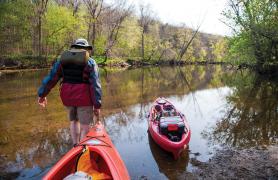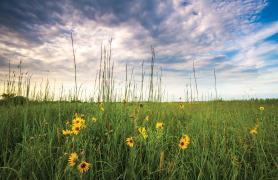The Gateway Arch in St. Louis, Union Station in Kansas City, or championship-winning baseball teams are part of what makes Missouri unique. But the Show-Me State’s heritage is as deep as the geology, soils, plants, animals, and streams that retain some of the same patterns that have occurred here for thousands of years.
While only covering about 2 percent of the landmass of the continental United States, Missouri ranks 21st in the nation in the number of native plants and animals that live here. Sixty-seven species of reptiles crawl, slither, swim, and bask in Missouri’s varied habitats — three times the number that occur in Montana. More species of native plants are found here than in all of Alaska. Missouri is home to the nation’s largest prairie remnants east of Kansas, while the Ozarks contain the largest block of wooded land in the Midwest, providing important breeding habitat for dozens of migratory songbirds.
Missouri boasts some of the largest freshwater springs in the world, and nearly 17,000 miles of streams and rivers flow through the state. It’s little wonder that Missouri ranks ninth in the nation in the number of native fish species that swim our waters. More than 7,000 caves riddle the rocky uplands of the Ozarks, providing habitat for many unusual creatures. A number of species, such as the Caney Mountain cave crayfish and the bluestripe darter, are found only in Missouri.
Forging a Legacy
In 1977, a group of forward-thinking biologists working for MDC and the Missouri Department of Natural Resources (DNR) came together to identify and preserve the last and best examples of the state’s prairies, forests, woodlands, savannas, glades, wetlands, and caves to be “permanently protected or managed for the purpose of preserving their natural qualities.” They laid the groundwork for what today has become the Missouri Natural Areas System. This system, made up of 188 special areas totaling 87,222 acres of land and water, are key pieces of Missouri’s natural heritage. Places like Ava Glades, Blue Spring, Diamond Grove Prairie, Jacks Fork, Mingo, St. Francois Mountains, and Stegall Mountain natural areas exemplify Missouri’s unique natural heritage. Today, natural areas are recognized by a partnership, the Missouri Natural Areas Committee, consisting of its original members — MDC and DNR — along with the Mark Twain National Forest, U.S. Fish and Wildlife Service, Ozark National Scenic Riverways, and The Nature Conservancy.
Keeping All the Pieces
Conservationist Aldo Leopold wrote, “To keep every cog and wheel is the first precaution of intelligent tinkering.” Leopold meant keeping all the native species of our varied habitats. Habitat conservation is the key to protecting rare species and keeping common species common. Natural areas make up just one-fifth of a percent of Missouri’s landmass, and yet they account for a large share of the state’s natural heritage resources, ranging from alligator snapping turtles to rare orchids. Today, populations of 433 Missouri species of conservation concern occur on designated natural areas, or 38 percent of all known occurrences of Missouri’s rare or declining species.
Natural areas conserve high-quality natural communities — groupings of native plants and animals and their associated soils, topography, and geology — ranging from deep soil prairies to rocky glades and murky swamps.
Natural communities are complex, with hundreds of native plant and animal species. For example, 320-acre Golden Prairie Natural Area, owned by the Missouri Prairie Foundation, contains over 300 different native plant species.
At the Little Niangua River Natural Area, fisheries biologists have found nine darter species, including two — the Niangua and the Missouri saddled darter — that are only found in Missouri. Our natural communities contain many examples of intricate ecological relationships, many of which still remain to be discovered. As an example, the seeds of many of our common springtime forest wildflowers, such as Dutchman’s breeches and bloodroot, are dispersed by ants.
Natural areas conserve many native species that are not endangered but are uncommon due to habitat loss. By providing habitat, natural areas keep species off the endangered list. These areas are also important reservoirs of native pollinator species, including native bees and butterflies. They are valuable reference sites for scientific studies photo label and seed sources for natural community restoration and reconstruction efforts on degraded lands.
Natural areas are a key piece of a wider portfolio that help keep Missouri’s native plant and animal species populations healthy. Missouri Natural Areas Committee agencies cannot conserve all species or habitats within natural areas alone. The effort requires a broad partnership of public and private land on natural areas, working farms, and sustainably managed forests to conserve our natural heritage.
Stewardship of Missouri Natural Areas
Natural areas are not wilderness areas. Many natural areas require some form of active management due to the disruption of natural disturbances like fire or flooding and the introduction of nonnative invasive species such as bush honeysuckle.
Lack of hands-on management can mean the loss of native biodiversity. Prescribed fire, thinning, exotic species control, and restoring water flow are all tools used to restore and maintain an area’s ecological integrity.
Natural Areas are Yours to Explore
Natural areas belong to Missourians. There are 85,336 acres of natural areas open to public access. All of these places provide opportunities for hiking, birding, nature photography, learning about natural history, or just enjoying the scenery. Nearly all are open to fishing if they have a stream, and 60 percent of natural areas are open to some form of hunting.
There are 105 miles of hiking trails and 23 miles of multi-use trails — biking, hiking, and horseback riding — including 16 miles of the Ozark Trail. There are also 56 miles of floatable streams that border or bisect a natural area. Regardless of your outdoor pursuit, you are likely to find a rewarding experience on a Missouri natural area.
How Do I Find a Missouri Natural Area?
To plan your visit or to learn more about natural areas, visit short.mdc.mo.gov/ZwX. In addition, Discover Missouri Natural Areas: A Guide to 50 Great Places, available at mdcnatureshop.com, brings to life the outstanding geological, biological, and ecological features of each natural area. Easy-to-use maps and stunning photographs complement the text.
Why is Native Plant Conservation Important?
Missouri natural areas are typically rich in native plant species, many of which are no longer common in the modern landscape. Conservation of native plant species may not seem important at first, but consider these facts:
- Over one-fourth of all prescription drugs today have plant origins. Taxol, which is used to treat ovarian cancer, was discovered in the bark of the Pacific yew, a native tree species that grows in the Pacific Northwest and was once considered a “trash tree.” Aspirin was first discovered from a chemical found in willow trees. Certain plants have yielded substances used in drugs to treat heart disease, cancer, and a variety of other illnesses. So far, scientists have investigated only a small fraction of the world’s species and have just begun to unravel their chemical secrets to find possible human health benefits.
- Native plants are the ecological basis upon which life depends, including birds and other wildlife. For example, over 75 percent of the diet of turkey poults is insects, especially grasshoppers and crickets. Research has shown the density of these insects to be much greater in remnant and restored woodlands and glades that have an abundant and diverse ground cover of native plants. Native songbirds also depend on healthy native plant populations. Research by entomologist Doug Tallamy has shown that native oak trees support over 500 species of caterpillars, whereas ginkgo, a commonly planted landscape tree from Asia, hosts only five species of caterpillars. Native songbirds often depend on abundant caterpillar populations, and many rely on them to feed their young. Tallamy found that over 6,000 caterpillars were fed to raise one brood of chickadees.
- Certain native plant species are critically important for the life cycle of some insects, including species of conservation concern. The regal fritillary depends on native violet species, especially prairie and arrowhead violet, during its caterpillar stage. Other examples include the zebra swallowtail whose caterpillars feed on paw paw and the iconic monarch butterfly whose caterpillars depend on milkweeds.
- Pollinators such as native bees pollinate 75 percent of all plants that produce food for human consumption. Native plants provide nectar for pollinators including hummingbirds, native bees, butterflies, and moths. They provide protective shelter for many mammals. The native nuts, seeds, and fruits produced by these plants also offer essential foods for all forms of wildlife.




















Also In This Issue


And More...
This Issue's Staff
Associate Editor - Bonnie Chasteen
Staff Writer - Larry Archer
Staff Writer - Heather Feeler
Staff Writer - Kristie Hilgedick
Staff Writer - Joe Jerek
Creative Director - Stephanie Thurber
Art Director - Cliff White
Designer - Les Fortenberry
Designer - Marci Porter
Photographer - Noppadol Paothong
Photographer - David Stonner
Circulation - Laura Scheuler






















